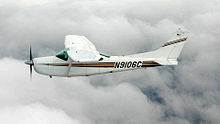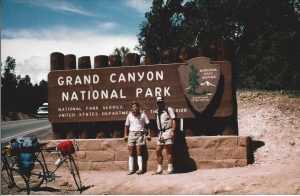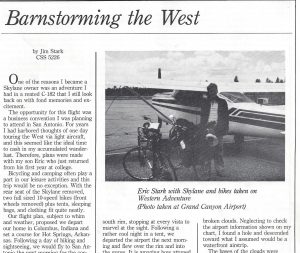Early, on a May morning, 1985, with the dawn barely an hour old, my oldest son, Eric, and I arrived at our Indiana airport to load various equipment planned for our two-week flying adventure across the United States. Sleeping under the wing at our various stops was not just a pipedream and we removed the back seat of the plane to make room for a tent, sleeping bags, camping gear and two ten-speed bicycles. Mom was also there that morning to send us off. The first leg of our flight was going to require an instrument flight plan because of an overcast that had ceilings down to 600 feet. Urgings from my wife that we wait until later in the day, were gently protested assuring her our first overnight stop on our way to Texas was Hot Springs, Arkansas, and the forecast southwest of Indiana was CAVU—Clear And Visibility Unlimited.

The Cessna lifted off smartly and within seconds we were sucked into the gray blanket of morning IMC—Instrument Meteorological Conditions. I have always enjoyed the challenge of flying on instruments. Wrapped in a womb of gray with the reassuring glow of the instruments confirming course, altitude, airspeed and attitude—being right side up—is a phenomenon I marvel at. Having said that, an even greater joy is the thinning of those clouds and then the dazzling moment you punch through the cloud tops and are bathed in brilliant sunlight.
Having bicycles with us was a convenient advantage. Although most of the airports we would be visiting—eleven in all—would have rental cars, the efficiency of being able tie down, order fuel, and pedal off took only minutes. Each of our stops—Hot Springs, San Antonio, El Paso, Grand Canyon, Palm Springs, Catalina Island, Death Valley, Salt Lake City, Ogallala-Neb, Rockford-Ill—were sightseeing wonderlands—well, perhaps not Rockford—and each could fill several paragraphs of this narrative, but for this blog I want to focus on the flying.
A bicycling tour of Hot Springs included a 40-mile ride to the top of the surrounding Ouachita mountains, elevation 2,950 feet. As we gazed down on the city below, I thought it was interesting how we marveled at that lofty sight even though we had just flown in from 8,000 feet.
The next day’s flight to San Antonio was routine with clear skies and an easy approach into KSAT airport. The following three days were a blur of business meetings, cocktail receptions, and a cursory visit to the Alamo. However, it was Eric’s and my travel plans that were most on our mind.
Texas is huge, as any Texan will boastfully tell you. Our four-hour flight heading west didn’t even get us out of the state. Flying across the border into Mexico was considered. All it would take is a flight plan clearance and a passport. However, because of the questionable Mexican and US relations and the risk of our airplane being held for some trumped up reason, we decided to land on the border at El Paso and walk across the Rio Grande border to sample Mexican sights and cuisine as an addition to our travel adventure.
Next stop was Grand Canyon National Park airport in Arizona. En route, across the vast western plains, we marveled at the wide-open spaces. Endless miles separated one habitation from another. An occasional cowboy on horseback encouraged our low pass and chandelle maneuver prompting his hat-waving salute. That kind of flying, the freedom to soar like red-tailed hawks is what aviation is all about for the purist. Swoop, climb, dive, and watch your shadow bouncing off the buttes and sandhills is nothing short of thrilling. The Navy gave me my wings. I refer not the gold insignia proudly pinned to my uniform, but the skill, knowledge, and confidence to maneuver in this third dimension. The Navy’s flight training is acknowledged as the best in the world—by all except those Air Force flyboys, of course, but even those guys in a weak moment will marvel at our 100-foot carrier decks compared to their 5-mile long runways. Years after the Navy, while flying general aviation aircraft and gliders, I found it second nature to deal with cross winds, stalls, and aerodynamic surprises which I credit to my Navy training.
I remember my first solo flight in the Navy. After a dozen flights with my primary instructor, I was given a solo check ride by a different pilot. My primary guy was demanding, critical, and demeaning whenever I didn’t perform to his expectations. We referred to such instructors as “screamers.” Would the check pilot be any less demanding, I wondered?
Meeting the check pilot on the ramp, he addressed me as “Jim,” not “Hey you” or “Get your head out of your butt.” His first words to me were, “Relax, this flight will be nothing more than a review of the maneuvers you have been practicing for weeks. Later, I’ll get out and you can do some touch and goes. You’ll do fine.” Wow, what a nice guy.
We did the steep turns, stalls, and various maneuvers, all of which received his quiet approval, “Nicely done.” The landings prior to the solo sign-off, in my mind, required ultimate safety. Therefore, I decided to wave-off any approach that did not meet precise airspeed or altitude guidelines. After two such wave-offs the instructor said, “Jim, those were all fine. Now, get this bird on the ground so I can get out and you can solo.”
I did. The aerodynamics of not having an instructor in the back seat were slightly different, but the awareness of flying alone was momentous. I’m flying! I’m in control. I am a pilot, damnit.”
Approaching Grand Canyon National Park Airport, Eric pointed out the gash in the terrain just north of the runway that was the Grand Canyon. We were tempted to do a quick fly over, but knowing that sight would be enjoyed fully later, we landed and loaded up our bikes for a two day stay in the campground. The road into the park paralleled the canyon. We stopped at the first vista overlook to see what USA Today would list as one of the NEW Seven Wonders of the World. Holy cow!, It got our vote. Two hundred seventy-seven miles long, 18 miles wide, and 4,265 feet deep, the canyon was awesome. Its enormity was spellbinding enough, but its colors, spires, crags, and buttes just left our mouths agape. Climbing back on our bikes, we couldn’t ride more than five minutes without taking another look.

The following day was filled with one marvelous sight after another. On our departure, we decided to fly INTO the canyon BELOW the rim. As it turns out, that was timely, as a short time later the FAA prohibited flights over the canyon. There had been aircraft accidents. A major disaster, years earlier involved the collision of two large airliners with no survivors. Just weeks before our visit, a sightseeing aircraft and a tourist helicopter collided, killing all aboard. The wreckage could still be seen on a wall of the canyon.
Reducing power to descend into the canyon was a very uncomfortable feeling. We weren’t going deep, just a few hundred feet, but any chance of an emergency landing in case of an engine failure evaporated once below the rim. I have never listened to the sound of our engine more closely, nor heard more suspicious noises. Eric’s comments during this were, “Dad, this is really cool. Let’s go deeper.”
“Err, naw. That’s enough. Time to be on our way to Palm Springs … whew.”
Hours spent in a cockpit are anything but boring. There is navigation to pay attention to as well as airspace regulations, i.e. restricted areas, minimum altitudes. etc. And you find yourself reflecting on past aviation experiences. I still do that and consider my flying memories a treasured history. I’ve been flying for over 58 years. Yeah, I’m an old codger. Those years include five in the Navy flying four different airplanes, and then 54 additional years flying some 16 different general aviation aircraft and 4 different glider models. The general aviation planes included single-engine, twin-engine, two-seaters, four seaters, retractable gear, and aerobatic airplanes. The logbook of my Navy years includes the bureau numbers of the different airplanes I flew. I carry the list of those numbers in my wallet and every once in a while, I’ll see a picture of an airplane in a magazine or at an airport somewhere—or a boneyard—and see it was an airplane I once flew. I flew 22 different Beech T-34 Mentor trainers, 70 different North American T-28 Trojan single-engine fighters, 43 Grumman S-2 twin-engine Trackers, and 28 different Lockheed P-2V Neptune patrol planes. I have 4,000 hours of cherished memories.
Landing in the desert at Palm Springs, I expected hot but dry temperatures. Opening the door of our Cessna, I couldn’t believe the humility. Commenting on that to the lineman, he said, “Yeah, it’s all those damn golf courses. It used to be dry heat here, but once all those movie stars, heads of state, and giants of industry built homes here, golf courses were created to entertain them. Those golf course irrigation systems raised our humidity levels by 50%.
The next morning, a short flight over Los Angelis would take us off the California coast on our way to Santa Catalina Island.
The smog over Los Angelis is well known but caught me completely by surprise. It would only be an hour flight from Palm Springs to Catalina, so even though there was heavy commercial traffic flying into and out of LA, there was a VFR (Visual Flight Rules) corridor through the LA traffic area, therefore, I did not file a flight plan. Over the metro area, the gray smog covered the city obscuring all those airliners I knew and heard on the radio to be climbing to altitude. We needed to climb to get clear of the soup. Passing through 10,000 feet we were still not smog free. The FAA says a pilot needs to be on oxygen above 12,500 if more than 30 minutes. It was at 12,500 before we felt we could finally see those big heavies emerging from the murk. At that point we were over the coast and just able to see a hint of Catalina Island, KVAX, 30-miles offshore. I told Eric we would be descending shortly but, in the meantime, if I passed out from lack of oxygen to take over until I came to again. When he scooted his seat a little closer to the rudder pedals, I realized he didn’t understand I was joking.
Off the California coast the sky was filled with towering cumulus clouds revealing only small openings of blue sky. I needed to find a hole to get down to sea level. Finding one, I lowered the flaps and closed the throttle, putting our plane in a nose-down descent. The cloud bases were around 1,500 feet. Here’s where I have to admit a blunder no experienced pilot should have made. I assumed (bad word when flying an airplane) that the Catalina airport was at sea level but approaching the island all I could see was a sheer rock wall coastline. That didn’t make sense because I had tuned in the tower’s radio frequency at KAVX and heard a number of airplanes landing and taking off. Then I checked my chart. Duh. Catalina’s “Airport in the Sky” was at 1,600 feet on the summit of Catalina’s mountain top. Uh-oh, now where was that hole we just descended through?
On top once again, I saw the approach end and far end of Catalina’s 3,000-foot runway began and ended at a cliff’s edge. Both were marked with cloud tops. My trusty co-pilot commented, “Dad, a landing neither too short nor too long is advisable.”
“Roger that!”
Downdrafts on short final required some of that Navy training I boasted about a few paragraphs earlier. NOTAMS (Notice To Airmen) stipulated that renters of airplanes were prohibited from flying to KAVX, until first making the flight with an instructor.
The resort town of Avalon by the sea is at sea level. So, Eric and I got on our bikes and with brakes smoking, coasted through the switchback, hairpin turns from mountain top to the beach. Our return the next day would be by hired van.
Our next day’s departure had us heading to Death Valley airport. It would be a unique landing. One of a pilot’s concerns when landing at a strange airport is knowing the airport’s sea level elevation. If flying a 1,000-foot landing pattern at an airport that has an elevation of 1,000 feet, the pilot must fly the pattern reading 2,000 feet on the altimeter. Furnace Creek airport—an appropriate name for the temperatures one finds there—has the lowest sea level elevation of any airport in the nation, two hundred and ten feet BELOW sea level. How about that!
Landing at Furnace Creek, I watched in astonishment as our outside air temp gage rose to 137 degrees. Death Valley looks like what you might imagine a place so named might look like. On the ramp, one forlorn looking faded old airplane sat bleaching in the sun with remnants of tumble weeds snagged around its wheels. There was nary a person in sight, but there was a small shack with toilet and pay phone. Anyone needing fuel had to call into town for a fuel truck.
Eric used the toilet facilities. After emerging, he exclaimed, “Dad, even the water in the toilet is hot!”
My question was, “How did you happen to discover that?”
We would not be spending the night in Death Valley, but while waiting for the fuel to be delivered, there was a campground and museum just a short walk away. The museum was open but unattended. We saw one camper in the campground. Time to climb back up to sea level and head for our next stop, Salt Lake City.
Salt Lake City sits in a bowl surrounded by mountains. I called approach control ten miles from the SLC airport at 10,000 feet. I was given vectors to landing so as to avoid departing and arriving commercial traffic. Directly over the runway, still at 10,000 feet, we were cleared for an immediate landing and asked to expedite. SLC elevation is 4,227, but I still had to lose nearly 6,000 to expedite the landing. Doing a steep turn 360 with full flaps and lowered wheels, I yet had to slip the last 500 feet to touch down mid runway. The tower’s brief comment was, “Good job, contact Ground Control 122.9”
The highlight of our Salt Lake visit was hearing a performance by the Mormon Tabernacle Choir. My 18-year-old son was greatly impressed. I can’t help but feel that later, Eric’s doctorial career as a Butler University music professor and as director of the Indianapolis Symphonic Choir which included conducting at Carnegie Hall, Kennedy Center, and world-wide concert halls, was influenced somewhat by that Mormon Choir performance.
We were now heading back east towards homeplate. Next camping stop, our last, would be at the lakeside town of Ogallala, Nebraska. Eric thought it amusing when my tongue became tied trying to smoothly say the word Ogallala in my radio communications.
Weather during this two-week adventure had been perfect, VFR (Visual Flight Rules) conditions almost the entire time. However, the flight from Utah to Nebraska had a storm front chasing after us out of the west. We no doubt would stay ahead of it until landing at Ogallala but didn’t anticipate much time after landing before it caught us. Once on the ground, we discovered it was a six-mile bike-ride to the campground. Loading the bikes with packs and camp gear, we were on our way with black clouds and lightning bearing down behind us. We just pulled into the campground when the storm hit. We ducked into the camp office as the ear-splitting thunder and lightning slammed the park bending trees to the ground with their fury and rain flooded the parking lot. The office clerk hardly looked up from his desk. “Yep, just another typical Nebraska rain shower he said.”
Thirty minutes later the storm passed, puddles evaporated, and we could set up our tent. The next morning, the final day of our sojourn, we ate the last of our freeze-dried camp food before pedaling off to the airport.
Checking weather, we discovered we would overtake the previous day’s weather front which had stalled a couple hundred miles east of us. The plan was to file an instrument flight plan, make our last fuel stop in Rockford, Illinois and then head for home.
What a wonderful air adventure it had been, two-weeks and 32.4 flight hours. Our trusty magic carpet didn’t miss a beat or suffer a hiccup the entire time. There would be a number of other exciting flying travels over the years, but this was one for the books. Or at least a major article in the 1986, March issue of Cessna Aircraft Owners Magazine.

Thanks Bob. It was a great adventure.
Jim
Charlie,
YTK Your too kind.
Jim
Thanks, Jim. It was a memorable experience.
Jim
It was hot enough, John.
Jim, sounds like an amazing trip. However, being one of those people that gets a little nervous in small planes I think I would have raised the temperature in that Death Valley outhouse by double. Great job!
One of your best.blog
AGS (another great story).
What a wonderful adventure! I’m very impressed with your piloting skills too!
Great story Jim. Your descriptions of various flight modes always brings back fond memories for me.
Thanks for sharing.
Eric,
Having you with me and being together is what made it special.
Dad
How wonderful to read this, and enjoy the memories all over again! It was an amazing adventure…every minute!!